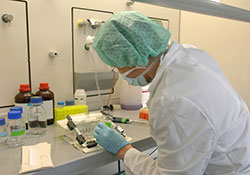Screening and early detection

iStockphoto
Early detection of cancer greatly increases the chances for successful treatment. The 2 components of early detection of cancer are early diagnosis (or downstaging) and screening. Early diagnosis focuses on detecting symptomatic patients as early as possible, while screening consists of testing healthy individuals to identify those having cancers before any symptoms appear.
Early diagnosis
Early diagnosis programmes aim at reducing the proportion of patients who are diagnosed at a late stage. They have 2 main components:
- increased awareness of first signs of cancer, among physicians, nurses and other health care providers as well as among the general public; and
- improved accessibility and affordability of diagnosis and treatment services, and improved referral from first to secondary and tertiary levels of care.
Early diagnosis is particularly relevant to cancers of the breast, cervix, mouth, larynx, colon and rectum, and skin.
Screening
Screening refers to the use of simple tests across a healthy population to identify those individuals who have a disease, but do not yet have symptoms. Examples include breast cancer screening using mammography or clinical breast exam, and cervical cancer screening using pap smears, human papillomavirus test or visual inspection with acetic acid.
Screening programmes should be undertaken only when their effectiveness has been demonstrated, when resources (personnel, equipment, etc.) are sufficient to cover nearly all of the target group, when facilities exist for confirming diagnoses and for treatment and follow-up of those with abnormal results, and when prevalence of the disease is high enough to justify the effort and costs of screening.
Even when implemented properly, screening programmes are associated with undesirable effects which include:
- falsely positive screening tests that result in additional testing, invasive diagnostic procedures and patient anxiety;
- falsely negative screening tests that provide false reassurance and can result in delayed presentation/diagnosis when symptoms appear; and
- over diagnosis/treatment of preclinical cancers that could have never cause symptoms nor pose a serious health threat and which involve unnecessary treatment that injures the patient.
The importance of these harms varies according to the screening tests, population groups targeted for screening and quality of screening programmes.
Weighing the harms against the benefits of screening has led WHO not to recommend mammography screening in women less than 50 years of age. Based on the existing evidence, mass population screening can be advocated only for cervical, breast and colorectal cancer.
Systematic prostate cancer screening of all men above a certain age using prostate-specific antigen (PSA) is not recommended by WHO. The high harm/benefit ratio has resulted in the abandonment of population-based PSA screening for prostate cancer in many countries of western Europe in the past years.



